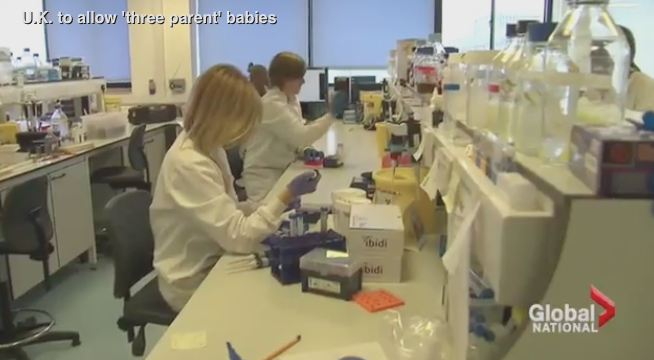“The big issue over the next 5 to 10 years is going to become how far do we go in pursuit of the perfect baby,”
British parliamentarians have voted to allow the creation of so-called “three parent” babies, using the DNA from three people to create human embryos. It’s hoped it will prevent some fatal genetic diseases from being passed on, but critics say no one’s sure where it will all lead. Stuart Greer reports.
Scientists who helped the baby’s parents say the goal was to prevent the child from inheriting a fatal genetic disease from his mother. His mom had four pregnancy losses and two babies who had passed away at eight months old and six years old from a brain disorder that typically results in death in early childhood.
The baby boy’s birth is revealed in a research summary published by the journal Fertility & Sterility. Scientists are scheduled to make a fuller presentation at the American Society of Reproductive Medicine’s annual meeting in Salt Lake City next month.
The baby boy was born five months ago to Jordanian parents on April 6, according to the magazine New Scientistand the Guardian in the U.K. The family had travelled to Mexico after consulting with American fertility specialists led by Dr. John Zhang of the New Hope Fertility Center in New York.
The technique is not approved in the United States, but Zhang told the magazine, “To save lives is the ethical thing to do.”
A spokesman for the fertility centre told the Associated Press that Zhang was not available for further comment on Tuesday. Others involved in the research referred questions to Zhang.
The child was at risk of inheriting DNA for Leigh syndrome, a severe neurological disorder that usually kills within a few years of birth. Only a minority of Leigh syndrome cases are inherited through the type of DNA that is targeted by the new method.
In tests, the mother was healthy but about one-quarter of her mitochondria was passing on the genes for Leigh syndrome, according to the report.
How do you make a “three-parent baby”?
The technique involved removing some of the mother’s DNA from an egg, and leaving the disease-causing DNA behind. The healthy DNA was slipped into a donor’s egg, which was then fertilized. As a result, the baby inherited DNA from both parents and the egg donor.
For years, British and American health officials have been debating “three-parent babies” made from the DNA of a man and two women. It was dubbed as a medical breakthrough, a promising way to create babies free from certain diseases, but critics said this technology is playing god in making designer children.
Scientists believed that three-person IVF could help women who carry DNA mutations have healthy babies. With a third person’s DNA worked into the baby’s genes, defects like blindness of epilepsy won’t be passed on.
In initial reports, DNA from a donor egg amounts to less than one per cent of the resulting embryo’s genes. Essentially, the baby is made with the genes of the intended mother and father, with the help of the healthy mitochondrial DNA from the donor embryo.
By February 2015, the United Kingdom became the first country that allowed three-parent babies. So far, no other country has introduced laws to permit the technique.
The UK’s health minister at the time, Earl Howe, said the move offered “real hope” to families.
“Families can see that the technology is there to help them and are keen to take it up, they have noted the conclusions of the expert panel…it would be cruel and perverse in my opinion, to deny [families] that opportunity for any longer than absolutely necessary.”
What about the ethical questions stemming from three-parent babies?
Because it’s “treating a disease,” medical ethicist Art Caplan says it’s fair game.
“These little embryos, these are people born with a disease, they can’t make power. You’re giving them a new battery. That’s a therapy. I think that’s a humane ethical thing to do,” Caplan, the director of medical ethics at New York University’s Langone Medical Center, told CNN.
What Caplan’s more concerned with is the “slippery slope” that might follow once health officials open the door to manipulating genetics to make a healthy baby.
“The big issue over the next 5 to 10 years is going to become how far do we go in pursuit of the perfect baby,” said Caplan.
-With files from Malcolm Ritter, the Associated Press
Source: carmen.chai@globalnews.ca

































1 Comment
Ways To Become Pregnant With A Boy | Infertility Treatment for Women
October 4, 2016, 6:51 pm[…] Baby boy born with DNA from 3 people, a first from new technique – His mom had four pregnancy losses and two babies who had passed away at eight months old and six years old from a brain disorder that typically results in death in early childhood. The … […]
REPLY